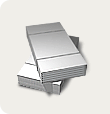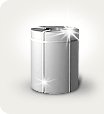There is a vast class of solid materials that do not expand when heated, as we used to think, but, on the contrary, shrink. These are thermoplastics - polyolefins. This class of materials includes high and low pressure polyethylene, polypropylene, polybutylene, and other polyhydrocarbons. They have the property of shrinking when heated due to their high molecular structure. Useful properties of heat-shrinkable materials (TUM) are widely used in everyday life and industry. Now you will not find such a field of activity where heat-shrinkable cable sleeves, heat-shrinkable packaging are not used, heat shrinkable tubing with glue , etc.
Where did it all start?
The first TUM was obtained and patented in the USA in 1939. Since 1940, there began a widespread production of heat-shrinkable polyethylene films. It was used as packaging. Imagine a batch of goods, instead of being packed in bags, boxes, and so on, was wrapped in a film that was seated, and received a cool, durable packaging. At that time, the technology for obtaining TUM was not yet perfect. The films released halogens and their compounds (chlorine, for example) into the environment. Therefore, in many countries such packaging was banned due to public outcry.
TUM properties.
Since then, science and technology have gone far ahead. The production of TUM, which does not emit halogens, has been established for a long time. The public calmed down. Since the main purpose of TUM is to shrink, therefore their main indicator is the compression ratio (relative shrinkage). This coefficient can be the same or different along different axes. For packing, it had to be the same in length and width, for a tube, compression in the radial direction is necessary, but not in length. Other properties are important:
- incombustibility;
- dielectric strength;
- mechanical strength;
- heat and frost resistance.
Where applicable.
- Manufacturing of heat shrinkable tubes (HERE).
- for insulating conductors in electrical engineering and electronics;
- to protect pipelines and their welds from corrosion;
- Manufacturing of heat-shrinkable packaging;
- Manufacturing of heat-shrinkable sleeves;
- for connecting the cores of wires (crimping, or soldering. Then couplings come with a copper sleeve, or with a tin one);
- for splice protection of fiber-optic cables;
- same for normal cables and wires.
- Manufacturing of connecting and power cable terminations up to 35 kV. For end sleeves, the product is called a heat shrinkable tray.
Usage example.
Heat-shrinkable tube with adhesive layer. Example of notation:
<





